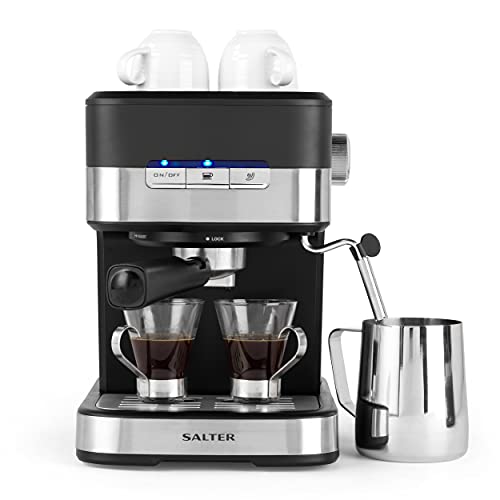Create Third Wave Specialty Coffee at Home With a Small Espresso Machine
Create third wave specialty coffee at home from bean to espresso in less than one minute. 19 bars of pressure create the best flavor and the water reaches ideal temperature in just 30 seconds.
This machine is sleek and slim, and will look great on the counter in your kitchen. It's also affordable and energy efficient, switching itself off after 9 minutes.
1. Simple to use
There are many options when you're looking to let a machine do the work for you. Most popular are capsule machines with automatics that allow you to insert pods by pressing a single button. There are also semiautomatics which require you to manually pack the portafilter, but they use an electrical pump to ensure consistent flow and pressure. These machines come with a milk frother to make cappuccinos and the latte. Fully automatic machines may be more expensive, but they can do everything for you. They grind and brew coffee, as well as heat and frothmilk.
The smaller sizes of espresso makers generally have a lower capacity of water than larger ones, which means you'll need refill them more often. They are more user-friendly and have a slimmer profile which means they can be put under cabinets.
This compact model from Mody is one of the cheapest we have reviewed, but it has enough power to make excellent espresso. It's got 15 bars of pressure that's sufficient to produce a great shot. It's small enough to fit in most kitchens, and slim enough to be put under cabinets. Its small size doesn't limit its capabilities the cup filter and drip tray are both easy to clean and remove and the tray has various settings for different kinds of drinks.
2. Easy to clean
A small espresso machine can be an excellent addition to any office or home, especially for those who prefer your coffee with just the slightest hint of milk. It is important to remember that espresso machines can be difficult to clean. This is because espresso machines use a lot of water and they require regular cleaning to ensure that they are operating properly and producing the best tasting coffee.

There are a myriad of ways to clean an Espresso Machine, but the most effective is to use a cleaning solution specifically designed for espresso machines. You can make this solution with vinegar, citric acid or a commercial descaling solution. It is recommended that you descale your espresso machine every two months.
Rinse the steam head and wand after each use. This will stop the buildup of coffee oil and other residues which could affect the taste. To do this, turn off the water supply to the espresso machine. Remove the portafilters as well as group heads. Then, brush the group heads as well as the gaskets using a toothbrush or coffee tool. Then, spray the inside of the group head and dispersion screens with a cleaning solution. Then, wash the group head and gaskets with cool water in order to remove any residue and then replace the portafilters.
3. Easy to maintain
The latest models are nearly 100% foolproof. They make it easy to make espressos of cafe quality at home. These models are also cheaper than ever before and are smaller in size on the counter.
The best small espresso maker is easy to maintain and will help keep your kitchen neat and organized. A clean coffee maker will produce better coffee and last longer. It is important to maintain your coffee machine. This includes cleaning the drip tray, the group head, and water tank.
After each use, wash the machine with soapy tap water. Deep clean it at least every six months. Espresso machines, however, require more frequent cleaning, at least once per week. This is due to the fact that espresso machine parts are more likely to collect dirt and dirt.
Clogged ports and filters are the most frequent reason for espresso machine failure. These blockages can result because of a poor tamping technique or grinding, or because the solubles present in the coffee haven't been fully extracted. Blockages can also be caused by a lack or regular cleaning.
It is recommended to follow a regular routine to prevent this. Clean the portafilters, baskets and gaskets frequently and scrub the steam wands and group heads thoroughly to remove any stuck coffee grounds. Some people make use of distilled vinegar and water to replace detergent.
4. Easy to store
A quick cup of joe will give you the boost you require. It's a standard in European and American coffee culture, and is even a popular choice in offices to keep workers going through the night shifts.
Small espresso machines are often light and only require a small counter space. They can be taken to work or on vacation and are a great option for those who travel often.
This kind of espresso machine is best demonstrated by the Ascaso Baby T Plus. It comes with all the features of a top-of-the-line machine including PID control, as well as volumetric programming, but is sized for a smaller home. It also helps to save energy as it heats or cools down slower than multiboiler machines.
Breville Bambino Plus is another fantastic option. travel espresso maker is a great all-in-one solution that can make cappucino, espresso and coffee. It makes use of a thermocoil to heating water to the temperature needed for coffee brewing, which is faster than older machines that utilized electronic thermostatic controls. It also cuts down on the time it takes to recover from the temperature of the boiler to that of the shot, which can enhance the flavor and consistency. It's also easy to use and requires little maintenance. It's the ideal espresso machine for people who don't want to spend money and time buying espresso at a coffee bar or shop every morning.
